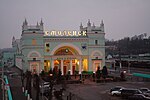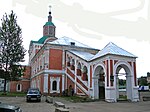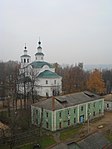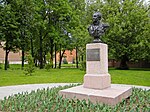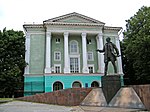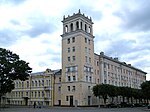Smolensk
Smolensk
Смоленск | |
|---|---|
City[1] | |
 Smolensk Art Gallery | |
 Flag  Coat of arms | |
show Location of Smolensk | |
 Smolensk Location of Smolensk | |
| Coordinates: 54°46′58″N 32°02′43″E / 54.78278°N 32.04528°ECoordinates: 54°46′58″N 32°02′43″E / 54.78278°N 32.04528°E | |
| Country | Russia |
| Federal subject | Smolensk Oblast[1] |
| Founded | 863[2] |
| Government | |
| • Body | Smolensk City Council[3] |
| • Head | Andrew Borisov |
| Area | |
| • Total | 166.35 km2 (64.23 sq mi) |
| Elevation | 242 m (794 ft) |
| Population | |
| • Total | 326,861 |
| • Estimate (2018)[6] | 330,025 (+1%) |
| • Rank | 54th in 2010 |
| • Density | 2,000/km2 (5,100/sq mi) |
Administrative status | |
| • Subordinated to | Smolensk Urban Okrug[1] |
| • Capital of | Smolensk Oblast[1], Smolensky District[1] |
Municipal status | |
| • Urban okrug | Smolensk Urban Okrug[7] |
| • Capital of | Smolensk Urban Okrug[7], Smolensky Municipal District[7] |
| Time zone | UTC+3 (MSK |
| Postal code(s)[9] | 214ХХХ |
| Dialing code(s) | +7 4812 |
| OKTMO ID | 66701000001 |
| Website | www |
Smolensk (Russian: Смоленск, IPA: [smɐˈlʲensk] (![]() listen)) is a city and the administrative center of Smolensk Oblast, Russia, located on the Dnieper River, 360 kilometers (220 mi) west-southwest of Moscow.
listen)) is a city and the administrative center of Smolensk Oblast, Russia, located on the Dnieper River, 360 kilometers (220 mi) west-southwest of Moscow.
The walled city in the center of Smolensk (along with the outskirts) was destroyed several times throughout its long history because it was on the invasion routes of the Mongol Empire, Polish–Lithuanian Commonwealth, Tsardom of Russia, First French Empire and Nazi Germany. Smolensk is known for its electronics, textiles, food processing, and diamond faceting industries.
Etymology[]
The name of the city is derived from the name of the Smolnya River. The origin of the river's name is less clear. One possibility is the old Slavic word смоль (smol) for black soil, which might have colored the waters of the Smolnya. An alternative origin could be the Russian word смола (smola), which means resin, tar, or pitch. Pine trees grow in the area, and the city was once a center of resin processing and trade. The Byzantine emperor Constantine VII (r. 913–959) recorded its name as Μιλινισκα (Miliniska).[10]
Geography[]
The city is located in European Russia on the banks of the upper Dnieper River, which crosses the city within the Smolensk Upland, which is the western part of the Smolensk–Moscow Upland. The Dnieper River flows through the city from east to west and divides it into two parts: the northern (Zadneprove) and southern (center). Within the city and its surroundings the river takes in several small tributaries.
In the valleys are stretched streets, high ridges, hills, and headlands form the mountain. Smolensk is situated on seven hills (mountains). The old part of the city occupies the high, rugged left (south) bank of the Dnieper River. The area features undulating terrain, with a large number of tributaries, creeks and ravines.
Climate[]
Smolensk has a warm-summer humid continental climate (Dfb in the Köppen climate classification) with short, rainy, and warm summers with cool nights and long, snowy, and bitterly cold winters.
| hideClimate data for Smolensk | |||||||||||||
|---|---|---|---|---|---|---|---|---|---|---|---|---|---|
| Month | Jan | Feb | Mar | Apr | May | Jun | Jul | Aug | Sep | Oct | Nov | Dec | Year |
| Average high °C (°F) | −4.5 (23.9) |
−3.6 (25.5) |
1.9 (35.4) |
10.9 (51.6) |
17.2 (63.0) |
20.4 (68.7) |
22.9 (73.2) |
21.5 (70.7) |
15.9 (60.6) |
8.5 (47.3) |
2.4 (36.3) |
−1.7 (28.9) |
9.3 (48.8) |
| Daily mean °C (°F) | −6.6 (20.1) |
−6.1 (21.0) |
−1.5 (29.3) |
6.3 (43.3) |
12.9 (55.2) |
16.5 (61.7) |
19.1 (66.4) |
17.6 (63.7) |
12.2 (54.0) |
5.9 (42.6) |
0.6 (33.1) |
−3.5 (25.7) |
6.1 (43.0) |
| Average low °C (°F) | −9.1 (15.6) |
−9.1 (15.6) |
−5.3 (22.5) |
1.1 (34.0) |
7.6 (45.7) |
11.5 (52.7) |
14.4 (57.9) |
13.2 (55.8) |
8.4 (47.1) |
3.2 (37.8) |
−1.3 (29.7) |
−5.5 (22.1) |
2.4 (36.4) |
| Average precipitation mm (inches) | 54 (2.1) |
47 (1.9) |
45 (1.8) |
47 (1.9) |
76 (3.0) |
84 (3.3) |
97 (3.8) |
79 (3.1) |
66 (2.6) |
69 (2.7) |
58 (2.3) |
51 (2.0) |
773 (30.5) |
| Source: https://en.climate-data.org/asia/russian-federation/smolensk-oblast/smolensk-413/ | |||||||||||||
History[]
Medieval origins[]
Smolensk is among the oldest Russian cities. The first recorded mention of the city was 863 AD, two years after the founding of Kievan Rus'. According to Russian Primary Chronicle, Smolensk (probably located slightly downstream, at the archaeological site of Gnezdovo) was located on the area settled by the East Slavic Radimichs tribe in 882 when Oleg of Novgorod took it in passing from Novgorod to Kiev. The town was first attested two decades earlier, when the Varangian chieftains Askold and Dir, while on their way to Kiev, decided against challenging Smolensk on account of its large size and population.
The first foreign writer to mention the city was the Byzantine Emperor Constantine Porphyrogenitus. In De Administrando Imperio (c. 950) he described Smolensk as a key station on the trade route from the Varangians to the Greeks. The Rus' people sailed from the Baltic region up the Western Dvina (Daugava) River as far as they could then they portaged their boats to the upper Dnieper. It was in Smolensk that they supposedly mended any leaks and small holes that might have appeared in their boats from being dragged on the ground and they used tar to do that, hence the city name.
The Principality of Smolensk was founded in 1054. Due to its central position in Kievan Rus', the city developed rapidly. By the end of the 12th century, the princedom was one of the strongest in Eastern Europe, so that Smolensk princes frequently controlled the Kievan throne. Numerous churches were built in the city at that time, including the church of Sts. Peter and Paul (1146, reconstructed to its presumed original appearance after World War II) and the church of St. John the Baptist (1180, also partly rebuilt). The most remarkable church in the city is called (1197, still standing); it was admired by contemporaries as the most beautiful structure east of Kiev.
Smolensk had its own veche since the very beginning of its history. Its power increased after the disintegration of Kievan Rus', and although it was not as strong as the veche in Novgorod, the princes had to take its opinion into consideration; several times in 12th and 13th centuries there was an open conflict between them.[11]
Between Russia, Lithuania, and Poland[]
Although spared by the Mongol armies in 1240, Smolensk paid tribute to the Golden Horde, gradually becoming a pawn in the long struggle between Lithuania and the Grand Duchy of Moscow. The last sovereign monarch of Smolensk was Yury of Smolensk; during his reign the city was taken by Vytautas the Great of Lithuania on three occasions: in 1395, 1404, and 1408. After the city's incorporation into the Grand Duchy of Lithuania, some of Smolensk's boyars (e.g., the Sapiehas) moved to Vilnius; descendants of the ruling princes (e.g., the , Kropotkins, Mussorgskys, ) fled to Moscow.

With tens of thousands of people living there, Smolensk was probably the largest city in 15th-century Lithuania.[citation needed] Three Smolensk regiments took part in the 1410 Battle of Grunwald (Tannenberg) against the Teutonic Knights. It was a severe blow to Lithuania when the city was taken by Vasily III of Russia in 1514. To commemorate this event, the Tsar founded the Novodevichy Convent in Moscow and dedicated it to the icon of Our Lady of Smolensk.
In order to repel future Polish–Lithuanian attacks, Boris Godunov made it his priority to heavily fortify the city. The stone kremlin constructed in 1597–1602 is the largest in Russia. It features thick walls and numerous watchtowers. Heavy fortifications did not prevent the fortress from being taken by the Polish–Lithuanian Commonwealth in 1611 after a long twenty-month siege, during the Time of Troubles and Dimitriads. Weakened Muscovy temporarily ceded Smolensk land to the Polish–Lithuanian Commonwealth in the Truce of Deulino. The city was granted Magdeburg rights in 1611 and became the seat of it was the seat of Smolensk Voivodeship for the next forty-three years.[12]
To recapture the city, the Tsardom of Russia launched the so-called "Smolensk War" against the Commonwealth in 1632. After a defeat at the hands of king Wladislaw IV, the city remained in Polish–Lithuanian hands. In 1632, the Uniate bishop built his apartments in Smolensk; they were later converted into the Orthodox Church of Saint Barbara. The hostilities resumed in 1654 when the Commonwealth was being affected by the Khmelnytsky Uprising and the Swedish deluge. After another siege, on September 23, 1654, Smolensk was recaptured by Russia. In the 1667 Truce of Andrusovo, the Polish–Lithuanian Commonwealth renounced its claims to Smolensk.
Modern history[]
Smolensk has been a special place to Russians for many reasons, not least for the fact that the local cathedral housed one of the most venerated Orthodox icons, attributed to St. Luke. Building the new Cathedral of the Assumption was a great project which took more than a century to complete. Despite slowly sinking into an economic backwater, Smolensk was still valued by the Tsars as a key fortress defending the route to Moscow. It was made the seat of Smolensk Governorate in 1708.

In August 1812, two of the largest armies ever assembled clashed in Smolensk. During the hard-fought battle, described by Leo Tolstoy in War and Peace (Book Three Part Two Chapter 4), Napoleon entered the city. Total losses were estimated at 30,000 men. Apart from other military monuments, central Smolensk features the Eagles monument, unveiled in 1912 to mark the centenary of Napoleon's Russian campaign.

At the beginning of World War I, the 56th Smolensk Infantry Division was first assigned to the First Army of the Imperial Russian Army. They fought at the Battle of Tannenberg. It was subsequently transferred to the 10th Army and fought at the Second Battle of the Masurian Lakes. In March 1918, while the city remained part of Russia, the Belarusian People's Republic, proclaimed in Minsk under the German occupation, declared Smolensk part of it. In February–December 1918, Smolensk was home to the headquarters of the Western Front, North-West Oblast Bolshevik Committee and Western Oblast Executive Committee. On January 1, 1919, the Byelorussian Soviet Socialist Republic was proclaimed in Smolensk,[13] but its government moved to Minsk as soon as the German forces had been driven out of Minsk several days later.
Soviet period[]
After the Revolution, for inclusion in its composition as claimed Smolensk Belarusian People's Republic and the Byelorussian SSR.[clarification needed] Since April 1918 Smolensk was the center of the Western Region, which is based on January 1, 1919, Byelorussian SSR was formed. January 7 BSSR government moved from Minsk and Smolensk already January 16, 1919 decision of the Central Committee of the RCP Smolensk region was transferred to the RSFSR. In 1920 was held the new provincial census, according to which the Russian population prevailed over Belarus, but the Belarusian party leadership until 1926 left no hope for the inclusion of Smolensk in the Belorussian SSR. In 1940, 18 km (11 mi) from Smolensk, the Katyn Massacre occurred.
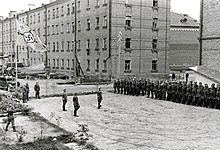
During World War II, Smolensk once again saw wide-scale fighting during the first Battle of Smolensk when the city was captured by the Germans on July 16, 1941. The first Soviet counteroffensive against the German army was launched in August 1941 but failed. However, the limited Soviet victories outside the city halted the German advance for a crucial two months, granting time to Moscow's defenders to prepare in earnest. Camp 126[further explanation needed] was situated close to Smolensk and at this time was mayor of Smolensk, with his deputy Boris Bazilevsky. Both of them would be key witnesses in the Nuremberg Trials over the Katyn massacre.[14] Over 93% of the city was destroyed during the fighting; the ancient icon of Our Lady of Smolensk was lost. Nevertheless, it escaped total destruction. In late 1943, Göring[dubious ]had ordered Gotthard Heinrici to destroy Smolensk in accordance with the Nazi "scorched earth" policy. He refused and was punished for it. The city was finally liberated on September 25, 1943, during the second Battle of Smolensk. The rare title of Hero City was bestowed on Smolensk after the war.
After the Germans captured the city in 1941, they found the intact archives of Smolensk Oblast Committee of the Communist Party, the so-called Smolensk Archive. The archive was moved to Germany, and a significant part of it eventually ended up in the United States, providing Western scholars and intelligence specialists with unique information on the local workings of the Soviet government during its first two decades. The archives were returned to Russia by the United States in 2002.[15][16]
Recent events[]
On April 10, 2010, a Tu-154 military jet carrying Polish president Lech Kaczyński, his wife, and many notable political and military figures crashed in a wooded area near Smolensk while approaching the local military airport. All ninety-six passengers died immediately on impact. The purpose of the visit was to commemorate the 70th anniversary of the Katyn massacre, in which some 22,000 Polish POWs were murdered by the NKVD.
In 2013, archaeologists of the Russian Academy of Sciences discovered and unearthed in the ancient temples in Smolensk dated to middle to second half of the 12th century, built on the left bank at the time the city was the capital of Smolensk principality. From unique object preserved walls in some places low, in others the height of human growth.[17]
In September 2013, Smolensk widely celebrated the 1,150th anniversary with funds spent on different construction and renovation projects in the city.[18] In celebration the Central Bank of Russia issued commemorative coins made of precious metals.[19]
Attractions[]
Owing to its long and rich history, Smolensk is home to many fine examples of Russian architecture ranging from the Kievan Rus period to post-WWII Stalinist architecture. Although the city was destroyed several times over, many historically and culturally significant buildings still remain, including a large number of churches and cathedrals. The most famous of these are the Cathedral of the Assumption, the Immaculate Conception Church, and the Church of St. Michael the Archangel, which is one of the few structures remaining in Russia from before the Mongol invasion.
House Engelhardt
House Budnikova
Sberbank Building
Editorial office of the newspaper Krasnoarmeyskaya Pravda
Smolensk Philharmonic Concert Hall
Department Store building
The A. Griboedov Smolensk Drama Theater
The Smolensk Kremlin[]
The Smolensk Kremlin, built at the end of the 16th century during the reign of Tsars Fyodor I Ioannovich and Boris Godunov, under the supervision of the architect Fyodor Kon, is one of the greatest achievement of Russian medieval architecture and military engineering.

The walls of Smolensk

Monument to Fyodor Kon
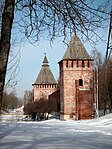
Bubleika Tower

Dolgochevskaya Tower

Oryol Tower
Churches and cathedrals[]
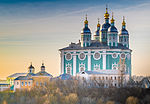
Cathedral of the Assumption

Church of St. Michael the Archangel
Church of St. Peter and St.Paul on Gorodyanska
Temple of St. John the Divine
Church of St. Nicholas
Ascension Cathedral
Epiphany Cathedral
Savior-Transfiguration Avraamiev Monastery
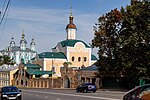
Holy Trinity Cathedral
Monuments[]
Being the site of many great battles in Russian history, Smolensk is home to many monuments commemorating its rich military history.

The Scorched Flower, a monument to child prisoners of Nazi concentration camps

Eagles monument, commemorating the centenary of the Russian victory over Napoleon
Monument to Alexander Tvardovsky and
Lopatinsky garden[]
Monument to the 2nd Sofia Infantry Regiment
Cannon in Lopatinsky garden
Monument to the defenders of Smolensk
Square of Memory of Heroes[]
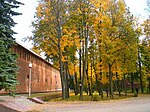
View of the Heroes' Square
The "Grateful Russia" Monument
The bust of Mikhail Kutuzov
Education buildings[]
Smolensk State University building

Smolensk Polytechnic College building
Smolensk Academy for Culture building
Smolensk College of Telecommunications building
Post-war Stalinist buildings[]
Administrative and municipal status[]
Smolensk serves as the administrative center of the oblast and, within the framework of administrative divisions, it also serves as the administrative center of Smolensky District, even though it is not a part of it.[1] As an administrative division, it is incorporated separately as Smolensk Urban Okrug—an administrative unit with the status equal to that of the districts.[1] As a municipal division, this administrative unit also has urban okrug status.[7]
Climate[]
Smolensk has a warm-summer humid continental climate (Köppen climate classification Dfb).
| hideClimate data for Smolensk | |||||||||||||
|---|---|---|---|---|---|---|---|---|---|---|---|---|---|
| Month | Jan | Feb | Mar | Apr | May | Jun | Jul | Aug | Sep | Oct | Nov | Dec | Year |
| Record high °C (°F) | 9.3 (48.7) |
9.0 (48.2) |
19.4 (66.9) |
28.0 (82.4) |
30.6 (87.1) |
31.2 (88.2) |
34.5 (94.1) |
37.2 (99.0) |
29.5 (85.1) |
24.8 (76.6) |
14.6 (58.3) |
9.8 (49.6) |
37.2 (99.0) |
| Average high °C (°F) | −3.8 (25.2) |
−3.4 (25.9) |
2.1 (35.8) |
11.2 (52.2) |
18.0 (64.4) |
21.0 (69.8) |
23.1 (73.6) |
21.7 (71.1) |
15.8 (60.4) |
9.0 (48.2) |
1.3 (34.3) |
−2.8 (27.0) |
9.4 (48.9) |
| Daily mean °C (°F) | −6.2 (20.8) |
−6.4 (20.5) |
−1.4 (29.5) |
6.3 (43.3) |
12.5 (54.5) |
15.8 (60.4) |
17.8 (64.0) |
16.3 (61.3) |
10.9 (51.6) |
5.3 (41.5) |
−0.9 (30.4) |
−5.1 (22.8) |
5.4 (41.7) |
| Average low °C (°F) | −8.9 (16.0) |
−9.6 (14.7) |
−4.9 (23.2) |
1.9 (35.4) |
7.3 (45.1) |
10.9 (51.6) |
12.9 (55.2) |
11.5 (52.7) |
6.7 (44.1) |
2.2 (36.0) |
−3.2 (26.2) |
−7.6 (18.3) |
1.6 (34.9) |
| Record low °C (°F) | −37.9 (−36.2) |
−36.8 (−34.2) |
−28.1 (−18.6) |
−19.8 (−3.6) |
−5.4 (22.3) |
−0.7 (30.7) |
4.4 (39.9) |
0.3 (32.5) |
−4.4 (24.1) |
−12.8 (9.0) |
−24.8 (−12.6) |
−35.2 (−31.4) |
−37.9 (−36.2) |
| Average precipitation mm (inches) | 48 (1.9) |
42 (1.7) |
42 (1.7) |
38 (1.5) |
61 (2.4) |
87 (3.4) |
90 (3.5) |
85 (3.3) |
70 (2.8) |
66 (2.6) |
58 (2.3) |
51 (2.0) |
738 (29.1) |
| Average rainy days | 9 | 8 | 10 | 15 | 17 | 18 | 16 | 16 | 16 | 18 | 15 | 11 | 169 |
| Average snowy days | 25 | 22 | 16 | 5 | 1 | 0 | 0 | 0 | 1 | 4 | 15 | 23 | 112 |
| Average relative humidity (%) | 87 | 84 | 78 | 69 | 69 | 75 | 77 | 79 | 83 | 85 | 89 | 89 | 80 |
| Mean monthly sunshine hours | 47 | 75 | 123 | 178 | 249 | 271 | 259 | 231 | 156 | 91 | 35 | 24 | 1,739 |
| Source 1: Pogoda.ru.net[20] | |||||||||||||
| Source 2: NOAA (sun, 1961–1990)[21] | |||||||||||||
Economy[]
Smolensk has several factories including the Smolensk Aviation Plant and several electronics and agricultural machinery factories.
Transportation[]
Smolensk is located on the M1 main highway and Moscow–Brest Railway. Since 1870, there is a railway connection between Smolensk and Moscow.[22] Local public transport includes buses and trolleybuses. Public transportation network includes buses, trolleybuses, trams, and marshrutkas.
There are two airports located in the outskirts of the city; Smolensk South (civilian) and Smolensk North (military); however, there are no regular flights scheduled to Smolensk South Airport.
Education[]
Smolensk is home to the Smolensk State University (SMOLGU) and the (SSMU); together with colleges of further education and other educational institutes.
Twin towns – sister cities[]
Smolensk is twinned with:[23][24]
 Colorado Springs, United States (1993)
Colorado Springs, United States (1993) Hagen, Germany (1985)
Hagen, Germany (1985) Kerch, Ukraine (2000)
Kerch, Ukraine (2000) Kragujevac, Serbia (2009)
Kragujevac, Serbia (2009) Targovishte, Bulgaria (2002)
Targovishte, Bulgaria (2002) Tulle, France (1981)
Tulle, France (1981) Vitebsk, Belarus
Vitebsk, Belarus
Notable people[]
- Sergey Belavenets (1910–1942), chess master, theoretician, and chess journalist
- Alexander Belyayev (1884–1942), science fiction writer
- Lydia Durnovo (1885–1963), art restorer and historian
- Dzham (born 1986), hip hop musician
- Peter Fishman (born 1955), sculptor
- Yuri Gagarin (1934–1968), cosmonaut
- Mikhail Glinka (1804–1857), composer
- Elizaveta Golovanova (born 1993), Miss Russia 2012
- Natalia Ishchenko (born 1986), swimmer
- Anatoly Kharlampiyev (1906–1979), founder of Sambo
- Eduard Khil (1934–2012), singer
- Patriarch Kirill of Moscow (born 1946), religious leader
- Ivan Kirpa (born 1978), boxer
- Vladimir Kirpichnikov (1903–1950), general
- Sergey Konenkov (1874–1971), sculptor
- Dina Korzun (born 1971), theater and film actress
- Pavel Kucherov, (born 1964), football player and coach
- Olga Kuzenkova, (born 1970), athlete
- Semyon Lavochkin (1900–1960), aircraft designer
- Maria Itkina (born 1932), runner
- Natalia Levchenkova(born 1977), biathlete
- Anatoly Lukyanov (born 1930), politician
- Morris Markin (1893–1970), businessman and founder of Checker Motors Corporation
- Gregori Maximoff (1893–1950), politician
- Timofey Mikhaylov (1859-1881), revolutionary, one of the assassins of Tsar Alexander II
- Uladzimir Navumau (born 1956), Belarusian politician and general
- Viktor Nemytskii (1900-1967), mathematician
- Anatoly Onishchuk (born 1946), sport shooter
- Taisiya Osipova (born 1984), political activist
- Yevgeny Polivanov (1891-1938), linguist, orientalist
- Grigory Potyomkin (1739–1791), statesman
- Andrey Starovoytov, (1915–1997), IIHF Hall of Fame inductee
- Aleksandr Tvardovsky (1910–1971), writer
- Olga Voronets (1926–2014), mezzo-soprano folk singer
Honors[]
Smolensk Strait between Livingston Island and Deception Island in the South Shetland Islands, Antarctica is named after the city.[25][26]
A Soviet post World War II project planned the creation of a light cruiser vessel named Smolensk. It was never constructed.
See also[]
References[]
Notes[]
- ^ Jump up to: a b c d e f g Resolution #261
- ^ Историческая справка
- ^ "Смоленский городской Совет - Официальный сайт органа местного самоуправления". www.smolsovet.ru.
- ^ "Результат запроса". www.gks.ru.
- ^ Russian Federal State Statistics Service (2011). Всероссийская перепись населения 2010 года. Том 1 [2010 All-Russian Population Census, vol. 1]. Всероссийская перепись населения 2010 года [2010 All-Russia Population Census] (in Russian). Federal State Statistics Service.
- ^ "26. Численность постоянного населения Российской Федерации по муниципальным образованиям на 1 января 2018 года". Federal State Statistics Service. Retrieved January 23, 2019.
- ^ Jump up to: a b c d Decision #164
- ^ "Об исчислении времени". Официальный интернет-портал правовой информации (in Russian). June 3, 2011. Retrieved January 19, 2019.
- ^ Почта России. Информационно-вычислительный центр ОАСУ РПО. (Russian Post). Поиск объектов почтовой связи (Postal Objects Search) (in Russian)
- ^ Paul Stephenson (April 21, 2000). "Byzantine Relations with Northern Peoples in the Tenth Century" (PDF).
- ^ Алексеев, Л. В. (1980). Смоленская земля в IX-XIII вв (in Russian). Moscow: Наука. pp. 111–115.
- ^ Никитин, Павел (1848). История города Смоленска. Moscow: Типография Селивановского. p. 171.
- ^ Marples, D. (2016). Belarus: From Soviet Rule to Nuclear Catastrophe. Springer. p. 11. ISBN 978-0230378315.
- ^ Sanford, George. Katyn and the Soviet Massacre of 1940: Truth, Justice and Memory, Part 804, 2005, p. 140. ISBN 978-0-415-33873-8.
- ^ [1] Archived January 29, 2008, at the Wayback Machine
- ^ "Prologue: Selected Articles". Archives.gov. October 19, 2011. Retrieved December 24, 2011.
- ^ "Интерфакс-Религия: Археологи обнаружили в Смоленске храм XII века". www.interfax-religion.ru.
- ^ 1150-летие Смоленска: от проектов к реализации Archived April 15, 2014, at the Wayback Machine
- ^ "К 1150-летию основания Смоленска отчеканили памятные монеты из драгоценных металлов". www.35kopeek.ru.
- ^ "Weather and Climate-The Climate of Somlensk" (in Russian). Weather and Climate (Погода и климат). Retrieved April 11, 2016.
- ^ "Smolensk Climate Normals 1961–1990". National Oceanic and Atmospheric Administration. Retrieved April 11, 2016.
- ^ Train Station in Smolensk (in Russian) Archived March 23, 2012, at the Wayback Machine
- ^ "Города-побратимы". smoladmin.ru (in Russian). Smolensk. Retrieved December 21, 2020.
- ^ "Colorado Springs Sister Cities International". coloradosprings.gov. City of Colorado Springs. Retrieved December 21, 2020.
- ^ Smolensk Strait. SCAR Composite Antarctic Gazetteer.
- ^ Ivanov, L. General Geography and History of Livingston Island. In: Bulgarian Antarctic Research: A Synthesis. Eds. C. Pimpirev and N. Chipev. Sofia: St. Kliment Ohridski University Press, 2015. pp. 17–28. ISBN 978-954-07-3939-7
Sources[]
- Администрация Смоленской области. Постановление №261 от 30 апреля 2008 г. «Об утверждении реестра административно-территориальных единиц и территориальных единиц Смоленской области», в ред. Постановления №464 от 27 июня 2014 г. «О внесении изменений в реестр административно-территориальных единиц и территориальных единиц Смоленской области». Опубликован: База данных "Консультант-плюс". (Administration of Smolensk Oblast. Resolution #261 of April 30, 2008 On the Adoption of the Registry of the Administrative-Territorial Units and Territorial Units of Smolensk Oblast, as amended by the Resolution #464 of June 27, 2014 On Amending the Registry of the Administrative-Territorial Units and Territorial Units of Smolensk Oblast. ).
- Смоленский городской Совет. Решение №164 от 28 октября 2005 г. «Устав города Смоленска (новая редакция)», в ред. Решения №1419 от 29 мая 2015 г. «О внесении изменений в Устав города Смоленска». Вступил в силу со дня официального опубликования, за исключением ��оложений, для которых установлены иные сроки вступления в силу. Опубликован: "Смоленские новости", №71, 22 декабря 2005 г. (Smolensk City Council. Decision #164 of October 28, 2005 Charter of the City of Smolensk (New Edition), as amended by the Decision #1419 of May 29, 2015 On Amending the Charter of the City of Smolensk. Effective as of the day of the official publication, with the exception of the clauses for which other dates of taking effect are specified.).
- "Była notatka o opcjach prawnych śledztwa". Były dyplomata o katastrofie smoleńskiej - Polsat News, polsatnews.pl [dostęp 2020-03-18] (pol.)https://www.polsatnews.pl/wiadomosc/2016-10-24/byla-notatka-o-opcjach-prawnych-sledztwa-byly-dyplomata-o-katastrofie-smolenskiej/.
Bibliography[]
External links[]
- (in Russian) Official website of Smolensk
- (in Russian) Travel in Smolensk
- (in Russian) Smolensk news
- (in Russian) Smolensk Wiki
- (in Russian) Homepage of the Smolensk fortress
- Some photos of the Smolensk fortress
- More photos of Smolensk
- (in English) Smolensk photos in Soviet times, 1983 in color
- Historic images of Smolensk
- (in Russian) Basketball in Smolensk
- (in Russian) News of Smolensk sport
- (in Russian) News of Smolensk medicine
- The murder of the Jews of Smolensk during World War II, at Yad Vashem website.
- Smolensk, Russia at JewishGen
- Smolensk State Medical University
 Smolensk travel guide from Wikivoyage
Smolensk travel guide from Wikivoyage
- Smolensk
- Forts in Russia
- Portages
- Smolensk Voivodeship
- Smolensky Uyezd
- Populated places on the Dnieper in Russia









